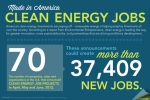The Energy Department plays a key role in moving innovative energy technologies developed in research labs across the country into the commercial marketplace, fueling the innovation engine that powers the U.S. economy. Bridging the gap between research and development (R&D) and commercial deployment is crucial to the Department’s mission, because it creates globally competitive industries in the United States, enables significant cost-savings for industries and consumers, and creates good jobs for Americans. From advanced battery technologies and new biofuel technologies to clean energy generation and energy efficient products and buildings, the Department’s Office of Energy Efficiency and Renewable Energy (EERE) has played an important role in bringing novel technologies from lab to market:
Advanced Batteries Technology and Biofuels – Advanced battery research, which began over 20 years ago at Argonne National Lab, enabled the development of the breakthrough cathode technology that helps power the Chevy Volt. Energy Department investments are laying the foundation for a strong U.S. advanced battery manufacturing industry, creating jobs and positioning the U.S. to compete and lead in this field as the growth of battery companies like A123, Johnson Controls and Saft America demonstrate. Simbol Materials has built on more than 20 years of R&D at Lawrence Livermore National Lab (LLNL) and Brookhaven National Lab (BNL) to pioneer high-volume extraction of lithium, manganese and zinc from geothermal brines – enough material to produce hundreds of thousands of advanced batteries per year from one 50MW geothermal power plant on the Salton Sea. Companies advancing cellulosic and algal biofuels like INEOS, LanzaTech and Solix BioSystems are likewise leveraging Department investments in innovative R&D to bring domestically-produced fossil fuel substitutes to market.
Clean Energy Generation – Energy Department investments have played a key role in the commercialization and deployment of the entire spectrum of clean energy technologies. The manufacturing process behind industry leader First Solar’s low-cost, thin-film photovoltaic (PV) panels was developed through more than a decade of collaboration with scientists and engineers at the Department’s National Renewable Energy Lab (NREL). Two dozen solar start-ups like Semprius, Primestar Solar and Innovalight have benefited from their engagement in the PV Incubator Program. Likewise, EERE’s Wind Program has supported entrepreneurial companies like Wind Tower Systems, building on a legacy of success that includes key early support for developing the turbines that became GE’s 1.5 MW and Clipper Windpower’s 2.5 MW machines. The world’s first tri-generation fuel cell and hydrogen energy station that co-produces-hydrogen in addition to electricity and heat also benefited from Energy Department support, as has Ocean PowerTechnologies’ PowerBuoy150 wave energy generation system.
Energy Efficient Products and Buildings – The Energy Department is committed to developing and deploying technologies that lower energy costs for American families and businesses. The Department is supporting smart window technology that Lawrence Berkeley National Lab (LBNL) estimates could save $10 billion in energy costs per year. A recent Pacific Northwest National Laboratory (PNNL) study that tracked the development and commercialization of Energy Department-supported R&D projects related to energy efficient products and technologies found that 11 were currently commercially available and 41 were expected to be commercialized within the next three years. The products and technologies currently on the market include a hybrid water heater by GE, an energy efficient white high-power LED by Cree, and a quiet-running heat pump for portable classrooms by Bard Manufacturing.
These are just a few of the examples of technologies that the Energy Department has helped to take from lab to market, helping American products compete in the global marketplace.




